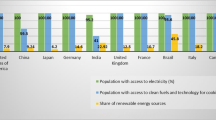Abstract
Within the last 25 years, liberalization (deregulation) of electricity markets around the world has been undertaken with the goal of replacing long-standing monopoly rights with fully competitive markets. In addition, many nations have begun employing “tradable green certificate” systems to promote electricity generation from renewable (“green”) energy sources (wind, solar, biomass, hydroelectric, etc.), with the primary objective of mitigation of greenhouse gas emissions from fossil fuel (“black”) producers. In this paper, we examine some welfare implications of the use of green certificate systems in electricity markets under alternative market structures. We demonstrate that under a wide variety of scenarios, an oligopolistic market structure may perform better in terms of welfare than a competitive market structure. We also demonstrate that there will typically be an optimal level of market power summarized by a conjectural variations parameter that depends on the cost structure of both green and black firms. Our model provides insights into the policy challenge of electricity market design and suggests an approach that could be applied in a more general model.



Similar content being viewed by others
Notes
In the U.S., TGCs are often referred to as “renewable energy credits” or “renewable energy certificates.”
In the present context output levels should be interpreted as “capacity” (Tamas et al. 2010). It should be noted that short-run marginal cost may be zero in existing wind and hydro systems.
Alternatively, the obligation to hold certificates may be placed on consumers.
In some cases there may be excess supply of TGCs, in which case a third party typically intervenes and purchases the unsold certificates at a “buy-out” price (Amundsen and Mortensen 2001). For simplicity we ignore this possibility and assume the certificate market clears.
As an anonymous referee has pointed out, it is important to note that the primary objective of a TGC system is the stimulation of the penetration of green electricity into the market. In this sense, a TGC system represents a government mandate and does not directly address the issue of market failure from black production. Assuming no additional inefficiencies from the bureaucratic administration of the TGC program, the ORP represents the socially optimal amount of renewable penetration, given consumer preferences and the fact that production costs for black electricity are lower than for green electricity but generate additional costs in the form of environmental damages.
Our choice of cost parameter values is intended to reflect the general fact that renewable electricity is more costly that fossil-fuel electricity (Zhou and Tamas 2010). In our examples, the cost parameter “a” corresponds to “ω” in Proposition 1.
For a regulatory adjustment process capable of determining (x CN (α ∗ CN ), y CN (α ∗ CN )) iteratively, see Currier (2013).
For a discussion of some difficulties associated with the empirical estimation of conjectural variation (i.e., “conduct”) parameters, see Corts (1999).
References
Amundsen, E. S., & Mortensen, J. B. (2001). The Danish green certificate system: some simple analytical results. Energy Economics, 23, 489–509.
Aune, R., Dalen, H. M., & Hagen, C. (2012). Implementing the EU renewable target though green certificate markets. Energy Economics, 34, 992–1000.
Buchanan, J. M. (1969). External diseconomies, corrective taxes, and market structure. American Economics Review, 59, 174–177.
Corts, K. S. (1999). Conduct parameters and the measurement of market power. Journal of Econometrics, 88(2), 227–250.
Currier, K.M. (2013). A regulatory adjustment process for the determination of the optimal percentage requirement in an electricity market with tradable green certificates. Energy Policy, 62, 1053–1057.
Currier, K. M., & Rassouli-Currier, S. (2012). A preliminary investigation of the optimal percentage requirement in an electricity market with tradable green certificates. Theoretical Economics Letters, 2, 216–220.
European Commission (EC) (2012). Competition: Energy and Environment 2013. Available at http://ec.europe.eu/competition/index_en.html.
Gopinath, M., & Wu, J. J. (1999). Environmental externalities and the optimal level of market power. American Journal of Agricultural Economics, 31, 825–833.
Koyama, K. (2013). Significance of competition policy in energy markets—Its bright and dark sides. Available at http://eneken.ieej.or/en/whatsnew/JPOIEL.html.
Kwoka, J. (2008). Symposium on restructuring in the U.S. electric power sector: a review of recent studies. Review of Industrial Organization, 32(3–4), 165–196.
Lipsey, R.G. & Lancaster, K. (1956–1957). The general theory of second best. The Review of Economic Studies, 24 (1), 11–32.
Morthorst, P. E. (2000). The development of a green certificate market. Energy Policy, 28, 1085–1094.
Neilsen, L., & Jeppesen, T. (2003). Tradable green certificates in selected European countries—overview and assessment. Energy Policy, 31, 3–14.
Tamas, M. M., Shrestha, S. O. B., & Zhou, H. (2010). Feed in tariff and tradable green certificates in oligopoly. Energy Policy, 38, 4040–4047.
Tsao, C. C., Campbell, J. F., & Chen, Y. (2011). When renewable portfolio standards meet: cap-and-trade regulations in the electricity sector: Market interactions, profits implications, and policy redundancy. Energy Policy, 39, 3966–3974.
Voogt, M., Boots, M. G., Schaeffer, G. J., & Martens, J. W. (2000). Renewable electricity in a liberalized market—the concept of green certificates. Energy and Environment, 11, 65–79.
Zhou, H., & Tamas, M. M. (2010). Impacts of integration of production of black and green energy. Energy Economics, 32, 220–226.
Acknowledgments
We would like to thank an anonymous referee for several important suggestions on an earlier version of this paper.
Author information
Authors and Affiliations
Corresponding author
Rights and permissions
About this article
Cite this article
Currier, K.M., Sun, Y. Market Power and Welfare in Electricity Markets Employing Tradable Green Certificate Systems. Int Adv Econ Res 20, 129–138 (2014). https://doi.org/10.1007/s11294-014-9463-2
Published:
Issue Date:
DOI: https://doi.org/10.1007/s11294-014-9463-2




